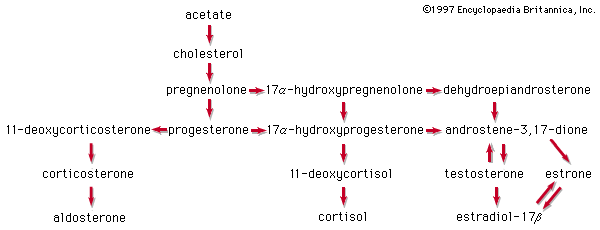Nelson Vergel
Founder, ExcelMale.com
I will be offering this blood test soon on www.DiscountedLabs.com

Fertil Steril. 2008 Feb; 89(2): 380–386.
Serum 17-hydroxyprogesterone strongly correlates with intratesticular testosterone in gonadotropin-suppressed normal men receiving various dosages of human chorionic gonadotropin
Setting:
Healthy volunteers in an academic research environment.
Patients:
Twenty-nine normal men.
Intervention:
We determined ITT concentration by testicular aspiration before and after treatment in men receiving exogenous testosterone to block endogenous gonadotropin production and randomly assigned to one of four doses of human chorionic gonadotropin (hCG) (0, 125 IU, 250 IU, 500 IU every other day) for 3 weeks.
Outcome measures:
The association between serum 17-hydroxyprogesterone, androstenedione and dihydroepiandrosterone (DHEA) and ITT.
Results:
With testosterone administration alone, serum 17-hydroxyprogesterone decreased significantly and increased significantly when 500 IU hCG was administered. End-of-treatment ITT strongly correlated with serum 17-hydroxyprogesterone. Moreover, serum 17-hydroxyprogesterone, but not androstenedione or DHEA, was independently associated with end-of-treatment ITT by multivariate linear regression.
Conclusion:
Serum 17-hydroxyprogesterone is highly correlated with ITT in gonadotropin suppressed normal men receiving testosterone and stimulated with hCG. Serum 17-hydroxyprogesterone is a surrogate biomarker of ITT and may be useful in research and in men receiving gonadotropin therapy for infertility.
Keywords: intratesticular testosterone, 17-hydroxyprogesterone, male infertility, male contraception
Full Paper: https://www.ncbi.nlm.nih.gov/pmc/articles/PMC2674872/

Fertil Steril. 2008 Feb; 89(2): 380–386.
Serum 17-hydroxyprogesterone strongly correlates with intratesticular testosterone in gonadotropin-suppressed normal men receiving various dosages of human chorionic gonadotropin
Setting:
Healthy volunteers in an academic research environment.
Patients:
Twenty-nine normal men.
Intervention:
We determined ITT concentration by testicular aspiration before and after treatment in men receiving exogenous testosterone to block endogenous gonadotropin production and randomly assigned to one of four doses of human chorionic gonadotropin (hCG) (0, 125 IU, 250 IU, 500 IU every other day) for 3 weeks.
Outcome measures:
The association between serum 17-hydroxyprogesterone, androstenedione and dihydroepiandrosterone (DHEA) and ITT.
Results:
With testosterone administration alone, serum 17-hydroxyprogesterone decreased significantly and increased significantly when 500 IU hCG was administered. End-of-treatment ITT strongly correlated with serum 17-hydroxyprogesterone. Moreover, serum 17-hydroxyprogesterone, but not androstenedione or DHEA, was independently associated with end-of-treatment ITT by multivariate linear regression.
Conclusion:
Serum 17-hydroxyprogesterone is highly correlated with ITT in gonadotropin suppressed normal men receiving testosterone and stimulated with hCG. Serum 17-hydroxyprogesterone is a surrogate biomarker of ITT and may be useful in research and in men receiving gonadotropin therapy for infertility.
Keywords: intratesticular testosterone, 17-hydroxyprogesterone, male infertility, male contraception
Full Paper: https://www.ncbi.nlm.nih.gov/pmc/articles/PMC2674872/
Last edited:












